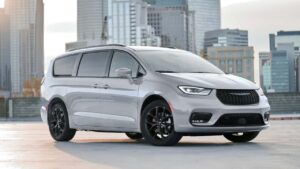Two Cars, Different Impact
The time has arrived to bid adieu to two exemplars of the car industry. Worthy of note is that the Chrysler 300 and Honda e are complete opposites in almost all respects, ranging from their outward appearances to their target demographics. But, what could be seen as the blending point of the pair? Well, each had a major influence on the automakers that made them.
The car industry was revolutionized by the introduction of Honda, a diminutive manufacturer from Japan, and Chrysler, an American heavyweight. These companies shifted automotive trends in their respective countries and far beyond.
The Chrysler 300 is a sizable sedan, offering V6 or V8 engines to turn its 198.6 inch length into a powerful muscle car. Taking some of its cues from the evergreen Mercedes-Benz E-Class, the 300 used to face stiff competition from cars like the Chevrolet Impala, Ford Taurus, and Toyota Avalon just to name a few. However, nowadays it stands as the only option in this sector.
In contrast, the Honda e is a stylish and fashionable electric B-segment hatchback tailored expressly for motorists based in Japan and all over Europe. Showcasing a vintage appearance that pays tribute to miniature cuboid metropolitan cars, this sophisticated motorcar has an up-to-date electrically powered drivetrain underneath. The Honda e was developed to become Honda’s first greatly popularized EV; unfortunately, that plan did not come to fruition.
The now famous 300 gave Chrysler a major benefit at the global level. What’s more, the early variants of the 300 (available from 2004 to 2010) made use of features derived from the Mercedes E-Class W211. With the release of the second generation in 2011, only slight changes were made when compared to the previous design.
Fiat’s acquisition of Chrysler presented an occasion to gradually widen the scope of the 300. In 2011, Lancia selected to change the badge of the 300 and offered it in Europe as the Thema. This attempt was a failure leading to only 6000 sales during the period 2011-2014. Although not a top seller, the 300 marked around 1.4 million units sold throughout almost 20 years (including the previously stated Themas). While not entirely successful, the 300 had a decided influence on the motor vehicle industry and was undoubtedly a potential life preserver for Chrysler.
Meanwhile, Honda has experienced the significance of the Honda e not through sales figures, but rather from the way it put a powerfully charged electric Honda on the market’s radar. Although its features weren’t extraordinary, the eye-catching design of this small hatchback elicited heaps of public interest. The car likewise holds historical importance as being the first auto to acclimatize Honda into the present mainstream electric vehicle marketplace.
The compact Honda e never aspired to revolutionize the realm of electric cars. Substantial obstacles lay in wait for it, with its hefty price tag and restricted range – major drawbacks in the embryonic moments of electrification. This much is evident: between 2020 and November 2023, Honda succeeded in moving no more than 12,500 of these miniature cars, among which over eighty percent were from Europe. And yet, this auto will remain in memory despite its miserable sales record.
Felipe Munoz, the Automotive Industry Expert at JATO Dynamics, is the writer of this piece.






Muchas gracias. ?Como puedo iniciar sesion?